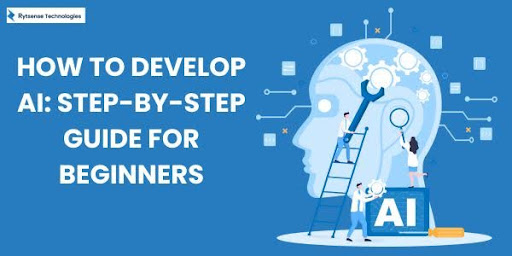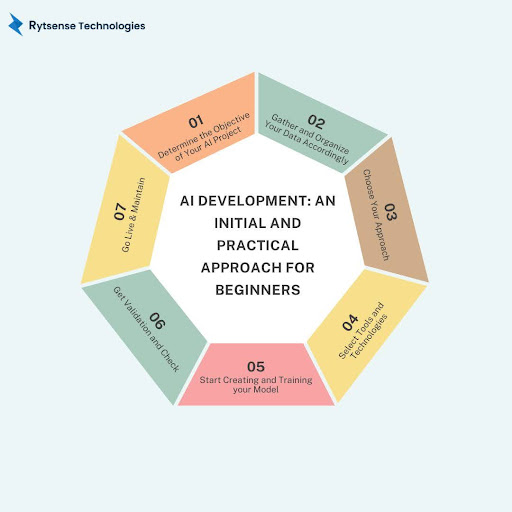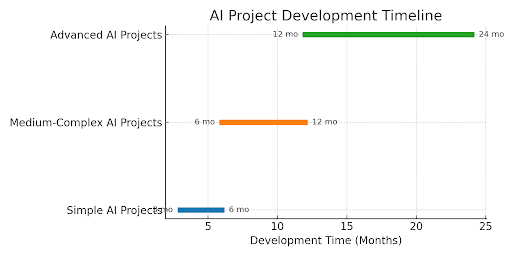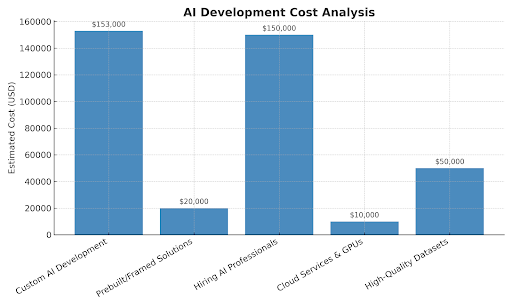-
Key Takeaways
- Begin with Python as it's a beginner friendly programming language for AI development and start with basic or simple algorithms before you move to complex ones.
- Data quality needs to be clean of high-quality and well- preprocessed than difficult ones.
- Follow the 7 step development process: Define goals, collect data, choose approach, choose tools, create or train models, test frequently, and deploy.
- You may begin building simple AI projects quickly with programming experience but if you want to master it, you need consistent practice and a lot of learning.
- It provides high demand opportunities with competitive salaries across various industries such as e-commerce, healthcare, finance, and transportation.
How to Develop AI: Step-by-Step Guide for Beginners

AI is changing the world as we know it. The global AI market is expected to grow 27.67% between 2025 and 2030, reaching a volume of $826.70 billion. Meanwhile, 77% of corporations have started to utilize or investigate the application of AI technologies. Now, it does not really matter whether you have programming experience or not; AI development can be pursued from many different angles. The 2025 figure of AI jobs available will reach 97 million, and the expected 50% increase in generative AI job postings between 2022 and 2024 will pave the way for many more transformative projects.
It’s easier than you might think to learn how to develop AI. Here’s an easy guide that may help you.
What You Need
To get started, you will need to learn how to code; Python will serve as an easier starting point for AI. You will need some basic math, as well as a computer and an internet connection.
Process Is As Follows
Step 1: Take an introductory course on AI and machine learning. You can find these on Coursera and YouTube, and they are free.
Step 2: Try basic projects. Create a simple chatbot or an image classifier and get them using TensorFlow or Scikit-learn.
Step 3: Get good and high-quality information for your test. Cleansing and organizing the information is essential for success.
Step 4: Pick a suitable algorithm for your issue. Begin with basic algorithms, like linear regression or decision trees.
Step 5: Use the information to teach your model. AI systems need to be trained so they can identify patterns and forecast.
Step 6: Evaluate how well your AI system performs by using new information.
Step 7: Make your AI accessible for others to use.
Key Tips
- To ease into AI, work on small, simple projects
- Make sure to practice on real-life projects
- Join AI communities to get help when needed
- Stay patient; AI development takes time
Like with anything new, focus on consistent practice combined with the right resources. It is possible to learn AI development successfully, especially if one keeps the hands-on projects in mind.
Before knowing how to develop AI, we need to look at what AI is and its particular concepts. AI is the technology that enables a computer to perform tasks. Simply put in easy words, what is AI? AI is the simulation of human intelligence in machines that are made to think, learn, and make decisions like a human brain.
AI systems may evaluate large sets of information, find patterns, and either predict trends or recommend actions based on that information. The aim of how to develop AI is to create systems that can adapt and improve their performance over time on their own, without explicit programming.
Also Read:
Benefits of AI in software developmentKey Components Of An AI System
When learning how to develop AI from scratch, there are key components that must be understood.
Data is the foundation of every AI system. Even the most sophisticated of algorithms cannot function when there is no available data as a foundation. When learning how to develop AI, you will realize that data collection, cleansing, and pre-processing are the most important first steps. Data can be in the form of text, images, audio, video, and even numbers.
Algorithms are the set of steps and logical rules that help machines learn from data. These comprises of algorithms for machine learning, like neural networks, decision trees, and support vector machines. Knowing these algorithms is important in figuring out how to create AI step by step.
Computing Power is required to operate large datasets and execute intricate algorithms. The processing of modern machines with AI needs more powerful hardware like GPUs and dedicated AI processors. These are needed to efficiently train and execute AI models.
Programming Languages and Frameworks expose the implementation of Artificial Intelligence tools. The most popular AI development languages are Python, together with the frameworks TensorFlow, PyTorch, and Scikit-learn.
The Model is the AI system that is trained to make predictions or decisions based on new data inputs. The process of creating and training models is fundamental in learning how to create AI.
Know More:
AI app development cost
What You All Need to Build an AI?
Learning the first principles of how to build AI demands having the proper tools, knowledge, and resources. This is everything you'll need to get started with AI development.
Having the right Programming Knowledge will help you develop AI from scratch. Python is the most recommended programming language due to its simplicity, making it easy to use, and due to its many libraries for AI. Other useful languages include R for statistics, Java for enterprise applications, and JavaScript for web-based AI applications.
The Mathematical Foundation focuses on understanding how to develop AI. Areas include statistics, linear algebra, calculus, and probability theory. If you’re not a math whiz, there’s no need to fret because many concepts can be learned on the go.
Development Environment is the most basic, essential, and crucial instruction for how to develop AI step by step. A computer with a strong CPU and a good GPU for model training will do. For people who are beginners, beginner cloud platforms, such as Google Colab, AWS, or Azure, offer useful resources.
AI Libraries & Frameworks help align the process of development. The most famous frameworks and therefore trusted comprises: TensorFlow, PyTorch, Keras, Scikit-learn, and OpenCV. These tools offer development algorithms to help with faster application development.
With Data Sources, you can find the required datasets to train the AI models. Datasets can be obtained on Kaggle, the UCI Machine Learning Repository, or tailored to suit projects.
Learning Resources will teach you the best practices for building AI. You may find online courses, tutorials, documentation, community forums, and more, which are available to support you during your learning.
AI Development: An Initial and Practical Approach for Beginners

Let us now consider how to develop AI step by step in an approachable manner that can be easily digested by beginners.
Step 1: Determine the Objective of Your AI Project
To develop AI, one must first figure out what is to be built. A chatbot, an image classifier, or a recommendation engine? Having clear goals makes choosing the right technologies easier.
Think about: What is the AI designed to address? Who will use it? What vital information do you have? What precision is expected? These questions, among others, will limit the scope and keep you on track for your development in a bid to understand how to develop AI in a more efficient manner.
Step 2: Gather and Organize Your Data Accordingly
Learning how to develop AI from scratch is best illustrated through data preparation, which is one of the most time-consuming tasks. For the AI project to be successful, it is vital to first obtain data from scraping, exploiting public datasets, or conducting surveys.
The next step is to clean & preprocess it, once you have gathered the data. This involves deleting duplicates, manages incomplete data, standardizing data entries, and even transforming the data to formats that algorithms can work with. The data must be clean for successful AI systems to be built.
Step 3: Choose Your Approach (AI Approach)
Think of the AI approach that is most suitable for your project. For beginners, it is recommended to start with machine learning, as it is the most frequent approach for developing an AI course. You can choose from supervised learning (uses labeled datasets), unsupervised learning (discovers trends from unlabeled datasets), and reinforcement learning (learns from actions taken).
Consider deep learning for more defined, complex, and pattern work, especially on images and text. Text-centric projects lend themselves best to natural language processing. In contrast, computer vision works more effectively with image-based projects.
Step 4: Select Tools and Technologies
Make choice of the tools, programming languages, and frameworks that best fit the purpose of your project. For the majority of AI projects, Python has an unmatched stature because of its assortment of libraries and the support it garners. AI models can also be built and trained with strong frameworks from PyTorch or TensorFlow.
Think about how much computing power you need as well. While a simple project may be finished or completed on a personal computer, a complex project involving deep learning would need cloud computing resources or specialized hardware.
Step 5: Start Creating and Training your Model
Begin building your AI model using your framework of choice. Start with basic algorithms, and as you progress, increase complexity as needed. This helps you learn how to develop AI bit by bit.
While the prepared dataset model is training, monitor the progress, tweak parameters, and check the model with separate data to ensure it is validating correctly.
Step 6: Get Validation and Check
Use multiple scenarios and edge cases to run your tests against the AI System. Use results or analytics like accuracy, precision, recall, or F1 score to evaluate the performance of your AI System. Learning how to develop AI requires understanding these methods of evaluation.
In the testing phase, take into account bias, fairness, and robustness. AI systems should be reliable and function the same way, no matter the conditions or the user group.
Step 7: Go Live & Maintain
If you are happy with how your model is performing, then you may go live! This may require building web or mobile applications and even linking them to other systems. Explore what tools and platforms are available to you that can aid in this stage.
Do keep in mind that AI systems need to be actively managed. Track your AI's efficiency with performance metrics, refresh models featuring new data, and fix problems that were created after going live.

Recommended AI Development Tools And Frameworks
As with any technological innovation, using the correct tools and frameworks is necessary for success. Each and every AI development tool has its own merits, and the AI development ecosystem has no shortage of options to choose from.
Top AI Frameworks for Beginners
Beginners usually turn to TensorFlow. It is developed by Google Brain, TensorFlow can be used from Python, JavaScript, C++, and Java. It is well-documented, has a massive community, and works well for both beginners and advanced developers.
The best option to consider when learning how to develop AI is called as PyTorch. It is popular among researchers due to its dynamic computational graphs as well as for its powerful debugging capabilities. Its proprietary user interfaces are quite intuitive and make PyTorch ideal for experimental AI projects.
Learning how to build applications with AI is easy with Scikit-learn because it is perfect for beginners. This library provides effective and easy-to-use tools for data analysis and mining. It also contains many algorithms for performing clustering, regression, and classification tasks.
With Keras, developing an AI becomes easier for newcomers because it works as a high-level interface for TensorFlow. It has powerful and easy-to-use application programming interfaces (APIs) and allows fast prototyping with neural networks.
Specialized AI Tools
When creating AI for computer vision, developing computer vision applications is key, as OpenCV is necessary. It has wide-ranging resources for image, object detection, and even facial recognition tasks.
For text analysis, NLTK and spaCy can process natural languages. These libraries are good for performing tokenization, part-of-speech tagging, and even sentiment analysis.
For developers working with large language models, LangChain is the newest and most powerful, as it allows the use of natural language understanding for complicated tasks.
Cloud-Based AI Development Platforms
Google Colab provides free access to GPU resources, making it perfect for beginners learning how to develop AI without expensive hardware. It offers pre-installed libraries and easy sharing capabilities.
To help train and develop AI, businesses can make use of AWS SageMaker and Azure Machine Learning, as they provide comprehensive cloud platforms tailored for training and developing AI at scale. These platforms provide managed services, automated model training, and simplified deployment.
Hugging Face has become a lot more popular for getting pre-trained models and transforming AI applications, as it offers thousands of models ready for use.
Time and Cost to Develop AI
The first consideration in developing an AI project is to have an understanding of the time and cost associated with it, as they are the first two pillars in the foundation of a project. They are always very different depending on the project’s complexity, benchmarks, team, and the needs of the business.
The Development Timeline
The development timeline for simple AI projects is around 3 to 6 months and includes basic chatbots and recommendation systems that use basic algorithms and have a low data processing requirement. AI projects of low complexity have a straightforward approach to their algorithms.
Medium-complex systems and projects are more sophisticated in nature. They may involve more sophisticated algorithms and be able to do extensive data pre-processing. Examples of such are advanced analytics platforms and image recognition systems, and they usually take 6-12 months to develop.
Advanced medical diagnostic tools, sophisticated AI systems, and other such projects take the longest to develop, as they can take anywhere from 12 to 24 months. All such systems are extremely sophisticated and require a lot of testing in addition to extensive validated research.

Cost Analysis and Insights

According to market research, the cost of developing an AI system typically ranges between $50,000 to $500,000+. In many different areas, the costs are incurred due to different factors.
Businesses incur costs of $6000 to $300,000 for customized AI. However, a framed solution is now available for the cost of $0 to $40,000 a year. This primarily deals with prebuilt and framed solutions for businesses.
The costs of hiring an AI engineer, data scientist, or ML professional for your project are extremely high due to their skills. These professionals’ salaries and learning to create AI systems are also quite expensive.
The cloud services and the required technology, such as GPUs, also incur the costs of data. The data costs as per project can reach hundreds to thousands of dollars, which can be hard to make available each month.
To have a well-performing AI system, top-tier training data is a must. However, these datasets are expensive but critical.
Building and training AI systems tends to be extremely difficult, so creating proper licensing for AI tools and frameworks, as well as presetting framed solutions, can make things considerably easier within a given budget.
Creating an MVP for AI systems greatly reduces the cost associated with advanced and expensive services. Getting straight to the ground can greatly reduce the expense and the challenging factors associated with it.
Use Open Source Tools to lower licensing costs. Most AI frameworks of any popularity offer strong free options that help develop AI skills.
Use Cloud Services for computing power to avoid hardware purchases. During the development phase, costs are easier to control with pay-as-you-use models.
Reduce development time and avoid costly missteps by partnering with leading professionals, like the best AI development company in USA.
Ethical & Legal Considerations in How To Develop AI
Learning how to develop AI requires understanding ethics and legal matters. These factors may help you in making sure the AI technologies you build are helpful to people and not harmful.
Certain Ethical Principles
Focusing on bias & fairness removes unnecessary complexity when learning how to develop AI. Make sure diverse populations are represented in your training data and that you validate your models on all demographic groups.
Privacy Protection when you know how to build AI requires some crucial frameworks for securing data, strict adherence to data privacy laws, & strong security protocols like GDPR and CCPA.
Transparency is crucial to make users understand the decision-making of AI systems. When possible, choose algorithms that give interpretable results so that you can explain the logic behind the software’s decision when developing AI.
Accountability means defining who can be held accountable for the decisions and results of the AI systems. Organizations must have systems in place to manage risks of identified errors or unintended consequences.
Legal Compliance Requirements
Following the rules of compliance for developing AI programs is difficult because the rules for AI are still forming and are spread out across the world.
When AI systems are in use, personalized details such as names, addresses, phone numbers, and emails need to be stored and kept carefully to prevent being disclosed. Make sure compliance is maintained with the local privacy laws of the region from which the data is gathered.
Privacy laws regarding trademarks need to be followed when AI projects are being developed and third-party datasets, algorithms, or pre-trained models are being used.
Risk to Compliance Requirements
In every step of development, Implement Bias Testing to mitigate risks and address discrimination against a particular group by identifying bias.
In AI systems, create audit trails that log actions taken, data accessed, and data processed to enable the AI to explain its actions.
To the projects of AI, create committees that will ensure alignment with societal expectations, value the organization, and ethical principles of the entity.
To adapt to changes in regulations, regular compliance checks will ensure that, in the course of the revisions, the newly introduced structural elements still comply with the legal regulations set for AI systems.

Developing AI Applications
When developing AI applications, being well-versed with the developments ensures that when the time to learn about the developments comes, strategic decisions will be made. These are the changes that will influence the next generation of AI development and applications.
New Developments
As new Natural Language Processing AI models are created, Natural Language AI becomes increasingly easier for new users. These models support advanced conversational AI and content creation.
Multimodal AI encompasses the integration of several types of text, photographs, and even audio so that a more advanced AI can become more sophisticated. This gives more users an opportunity to learn to develop AI in varying fields.
Edge AI has AI computation done on the device, which results in immediate computation and increases the safety of the user's data. This is very crucial for mobile devices and IoT applications when learning how to develop AI.
With Automated Machine Learning (AutoML), decisions on the model to be used, the hyperparameters, and even deployment are done automatically.
Development Models
AI development has been made easier with No-Code/Low-Code AI Platforms. These tools provide professionals with the ability to manage AI projects without the need for coding, thereby broadening the scope of AI development.
AI models can be trained with data sets in different locations with no need to centralize data through Federated Learning, thus solving the AI privacy problem.
With no requirements for human assistance, systems with the ability to adapt and enhance are known as Continuous Learning Systems. These AI systems are both stronger and more efficient, with the ability to self-manage.
Examples of Custom AI in Use
Knowing various use cases of AI brings to light the idea of developing it yourself. Custom AI is shifting business paradigms and is becoming increasingly useful in many industries.
Healthcare AI
Healthcare AI comprises of tools for diagnosis, medical image interpretation, drug development, and patient-specific treatment. AI also helps in forecasting patient outcomes, optimizing resource distribution, and enhancing overall treatment in hospitals.
AI in Business
AI is helping and assisting businesses with analyzing data, predicting customer behavior, detecting fraud, and automating various business processes. This is what is termed Business Intelligence. Companies make use of use AI to gain competitive advantages and improve operational efficiency.
Recommendation systems, price optimization, inventory control, and AI-powered customer service chatbots are all employed by e-commerce platforms. These programs have a major impact on sales as well as customer satisfaction.
AI in transportation
AI enables the transportation sector to safely and efficiently use autonomous vehicles, optimize routes, predict maintenance schedules, and even operate systems that manage traffic.
Entertainment AI
Entertainment uses AI to show content, developing video games, composing music, and enhancing user personalization on platforms. AI-powered algorithms are crucial for streaming platforms and gaming services.
Agriculture AI
Agriculture comprises a monitoring and predicting yields, detecting pests, and using farming machinery. AI makes it easier for farmers to achieve productivity and helps save on environmental costs.
Knowing these details helps us know how to develop AI solutions for specific users and organizational needs to solve problems in AI technology.
Building AI: Common Difficulties
Learning how to develop AI step by step comes with various challenges that learners should be aware of before or in advance. Understanding these challenges helps you develop your own strategies to tackle these matters.
Data Quality Problems are among the most common problems in AI development. Models trained, no matter how sophisticated the algorithms, will be useless if the data is poor. You can spend adequate time on data scrubbing, validation, and preprocessing to ensure success.
Two opposing sides make up the problem. Overfitting is when a model trained on data it is already familiar with does poorly, while underfitting is when a model does not capture existing systems. Finding the right balance in model complexity is critical for effective AI development.
The ability to experiment with elaborate models and larger datasets may be limited due to Computational Resources. You may think about cloud computing services or optimizing code to run efficiently with the existing hardware.
Algorithm Selection can be very confusing for beginners. In the problem domain that you are dealing with, out of the plethora of algorithms, only one is the best, and it is determined only by problem-specific experience and experimentation. Start with the basic algorithms and don’t be afraid to try out more complex ones later.
Another Bias and Fairness issue is the production of discriminatory results by AI systems. Creating unbiased systems and ensuring fairness relies heavily on the data, algorithm, and the method of evaluation employed, and thus demands sophistication.
Scalability Challenges - these problems emerge while transitioning from prototype to production systems. Taking these criteria into account during the design phase can save the need for costly design modifications later in the process.
When dealing with stakeholders who require an explanation of the decisions made by the AI systems, the issue of interpretability arises. It is still a problem of balancing the quality of the results of the models and the extent to which the models are understandable.
Major Practices for Successful AI Development
Your chances of success or achievements while learning how to develop AI can be greatly boosted if you adhere to best practices. These practices help you avoid the most common mistakes and design reliable AI systems.
- Start Simple and incrementally increase the complexity. Launch advanced deep learning projects only after you work with simple algorithms and datasets. Doing so will increase your understanding and confidence in a gradual manner.
- Focus on Data Qualityas you develop. Make sure to understand your data, its cleansing, and representation relative to your problem domain. Keep in mind that AI development follows the principle of “garbage in, garbage out”.
- Version Control Systems allow you to keep track of changes, work with colleagues, and create different iterations of your AI systems. This will be critical as your work becomes more complex.
- Implement Proper Testingon the AI systems to validate their performance. For the training, validation, and testing of any given model, it will work best to use different datasets.
- Document Your Work and pay attention to the details like sourcing the data, pre-processing it, outlining model architectures, and assessing the output. You and others will have an easier time understanding, maintaining, and troubleshooting AI systems with thorough documentation.
- Consider Ethics and Bias on the very first day of your project. Analyze the potential societal impact, enable fairness among different user groups with affirmative actions, and prevent misuse.
- Stay Updated on the AI research and tools that are evolving and emerging. Your work will be optimized once you learn how to use the ever-evolving technology.
- Collaborate and Learn from AI and join forums as well as conferences to engage with other developers and decide to learn and share knowledge from their experiences.
Also Read:
Custom AI Development CompanyWhy Choose Rytsense Technologies for Custom AI Development?
While assisting with custom AI projects, working with a professional development company will greatly increase your rate of success, as professional development companies will help you succeed faster. Rytsense Technologies specializes in custom AI development solutions, which makes it one of the most prominent AI service companies, and conveniently, it will help you realize the value of your business with its bespoke AI services.
From the best AI development company in USA. One can see that Rytsense Technologies does boast experience in the use of AI, with commendable experience in their fields with machine learning, natural language processing, computer vision, and deep learning. The AI development team understands how to develop AI that used to be a complex task, enabling the business to get industry-specific, tailored solutions and measurable, impact-driven outcomes.
The company provides full-service AI development from consultation and strategy to creation and design, testing, and deployment. They are ready to work with you, whether you are a fresh startup looking to wire intelligent AI capabilities into your systems or a business looking to transform your company’s processes into intelligent automated workflows. Rytsense Technologies will be ready with adjustable solutions tailored to your requirements.
A successful AI implementation requires deep industry expertise to ensure that business goals are met. Rytsense Technologies applies AI to its operations, considering every business aspect with technical precision. Their strong focus on industry trends and technologies also places their clients ahead of innovative solutions and industry best practices.

Conclusion
Knowing how to develop AI indicates a thrilling adventure and exploration into one of the most fascinating areas in modern technology. Do remember that how to develop AI from scratch takes a great deal of effort and learning. For the best achievement, a solid base of theory and practical projects is a must.
There are no limits to the number of project opportunities in AI development, whether you decide to go solo or pair up with knowledgeable teams like Rytsense Technologies. This is the best approach for positive career outcomes that is aimed at solving important real-world issues and building the technology of the future.
Just like everyone, experts were once novices. Be sure that you focus on mastering how to develop AI. If you want to bring change in the tech world, it is important to stay up to date and dedicated. The field is transforming day by day. Applying the right methods will change the solutions you create. You will, in fact, make a major difference in the world.
Forget the fact that the world is entirely dominated by technology. Shift your focus to crafting tomorrow’s systems. AI, on the other hand, is a vital and strong trait one should harness. There isn’t a better time than now to start your journey. The community of developers building the intelligent systems will always welcome you.

The Author
Karthikeyan
Co Founder, Rytsense Technologies